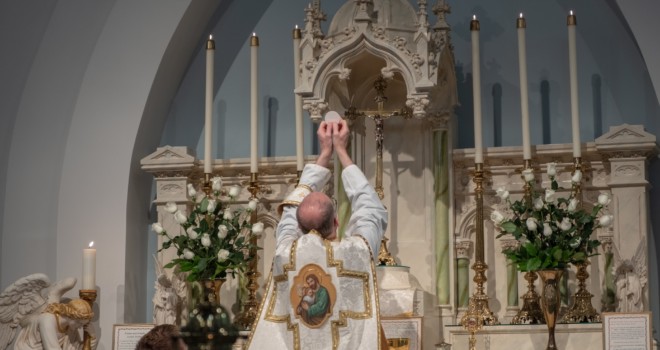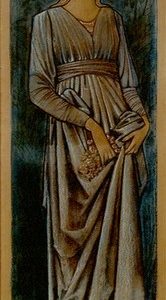Cloaked in a cloud, with a face as bright as the sun and feet of fire, he saw the angel descending from heaven. The voice of the angel was as a roaring lion. He was so large that one foot rested on the sea while the other touched the land.
In his hand was a small scroll:
Then the voice that I had heard from heaven spoke to me again and said, “Go, take the scroll that lies open in the hand of the angel who is standing on the sea and on the land.”
So I went up to the angel and told him to give me the small scroll. He said to me, “Take and swallow it. It will turn your stomach sour, but in your mouth it will taste as sweet as honey.” I took the small scroll from the angel’s hand and swallowed it. In my mouth it was like sweet honey, but when I had eaten it, my stomach turned sour (Revelation 10:8-10).
The above scene from the Book of Revelation culminates in the Apostle John being called to prophesy. The eaten scroll delivered from heaven by an angel seems a vivid metaphor for how God inspired the writing of the Scriptures: John internalizes the divine Word, he digests it—it fires not just his mind but fills his body.
But there’s something more going on here. In this image of John eating the scroll, Catholic commentators also see a figure for the Eucharist. As one Catholic writer, Stratford Caldecott explains,
Since Jesus is the Word of God in person, the representation of the Eucharist by an edible scroll is of course quite appropriate. The possible Eucharistic symbolism here is strengthened by the fact that the angel ‘with a rainbow over his head’ who holds the little scroll (Rev. 10:1) is speaking with seven thunders words that John is told to seal up and not write down—for the holiest things should be exposed only to those fully prepared and initiated.
In fact, many scholars believe that not only is this passage describing the Eucharist, but that the entire book is a depiction of sorts of the heavenly liturgy of which the Mass is a participation. Yes, that’s right, Revelation, the book of monsters and wonders is a biblical commentary on the Mass.
That might seem incredible until you start looking for parallels between Revelation and the Mass. One Bible study guide has tallied at least 100 specific connections between the book and the liturgy. Here are some that especially stand out:
The Penitential Rite of the Mass is mirrored in the repeated calls for repentance that dominate Rev. 2 and 3. Throughout the book, the altar is at the center of the word and action. Particular reverence is shown to the altar, such as in Rev. 6:9 and 8:3-5. There is also the Liturgy of the Word in Rev. 5, in which the slain lamb on the throne is the only one deemed worthy to open the scroll and read. The Sanctus, acclaimed during the Liturgy of the Eucharist, is taken from Rev. 4:8-11 in a scene which should ring somewhat familiar to Catholics:
The four living creatures, each of them with six wings, were covered with eyes inside and out. Day and night they do not stop exclaiming:
“Holy, holy, holy is the Lord God almighty,
who was, and who is, and who is to come.”Whenever the living creatures give glory and honor and thanks to the one who sits on the throne, who lives forever and ever, the twenty-four elders fall down before the one who sits on the throne and worship him, who lives forever and ever. They throw down their crowns before the throne, exclaiming:
“Worthy are you, Lord our God, to receive glory and honor and power, for you created all things; because of your will they came to be and were created.”
Those in attendance kneel after the singing of the Sanctus—a practice which has been retained in the U.S. Catholic Church. And note that the worshipers proclaim the ‘worthiness’ of the Lord to receive glory, honor, and power, whereas in the Mass we confess our ‘unworthiness’ to receive the Lord. Later in the Mass we sing the Agnus Dei, lamb of God. Revelation is full of references to the divine lamb—including in the chapter that immediate follows the above.
The heavenly liturgy continues in the vision of Revelation 15 and 16, which dwells on the bowls and cup of fury. Angels are appointed to pour the bowls out over the earth. One brings a plague of sores out on sinners who worshipped the beast. Another turns the sea to blood. A third is poured on the sun, setting off some kind of a cosmic chain reaction in which scorching flames are showered on the earth.
Now, one might wonder, how could this possibly be related to the Eucharistic bread and wine?
As this Bible study guide explains, what in Revelation are depicted as judgments in the liturgy become ‘gifts of grace.’
This is not such a strange thing as it might at first seem.
Think of the crossing of the Red Sea, which was a moment of deliverance for the Israelites yet also one of destruction for the Egyptians. And again: the Genesis flood blotted out mankind yet was also a moment rebirth for the human race. Both events are viewed as foreshadowing baptism, the first sacramental gift of grace in our lives.
In a Eucharistic context, St. Paul also explains how the eating of the bread and the drinking of the wine can become an instance of judgment for those who fail to discern in them the Body of Christ (1 Corinthians 11:29).
All this has led some scholars to describe Revelation as a biblical commentary on the liturgy. If so, what does it tell us about the Mass?
In the first place, Revelation helps to disclose to us the hidden meaning of the various elements of the Mass. (Incidentally, the Anglicized Greek name for Revelation, Apocalypse, comes from the Greek verb for uncovering or revealing. Revelation is of Latin derivation.)
For example, in Revelation 14, an angel harvests the grapes of the earth and throws them into the ‘great wine press of God’s fury.’ When the wine press is trodden, it unleashes a tide of blood that rises as high as a horse and reaches out for 200 miles—certainly a gripping image of the reality of the Eucharistic wine.
Speaking of hidden Eucharistic meanings, earlier in Revelation 2:17 believers who are victorious over idolatry are promised that they will receive the ‘hidden manna’ upon entry into heaven—an obvious allusion back to the manna of the ancient Israelites, which itself was a forerunner of the ‘bread of heaven’ Christ gave us.
Overall, Revelation places the liturgy for us at the center of time and space. In chronological terms, it reinforces the fact for us that the liturgy is not only a dynamic ‘remembering’ of Christ’s sacrifice but also a dynamic reaching forward in time to the end of the world when Christians will be celebrating the liturgy in heaven. In this way, the liturgy also spans space, making heaven present on earth.
For the individual Christian in today’s world, Revelation has a special significance in the context of the liturgy.
In the wake of Vatican II, Church has sought to restore the majesty and liturgical grandeur of the Mass that has in some places been lost (due to misinterpretations and abuse of the reforms implemented by the council). Turning to the Apocalypse certainly can help instill greater reverence among individual believers at Mass.
So next time you find yourself distracted in line to receive Holy Communion, just envision the cloud-cloaked angel with feet of fire handing you that scroll of honey. Because the reality of what you are about to receive is even greater than that.
✠
Photo by Shalone Cason on Unsplash












